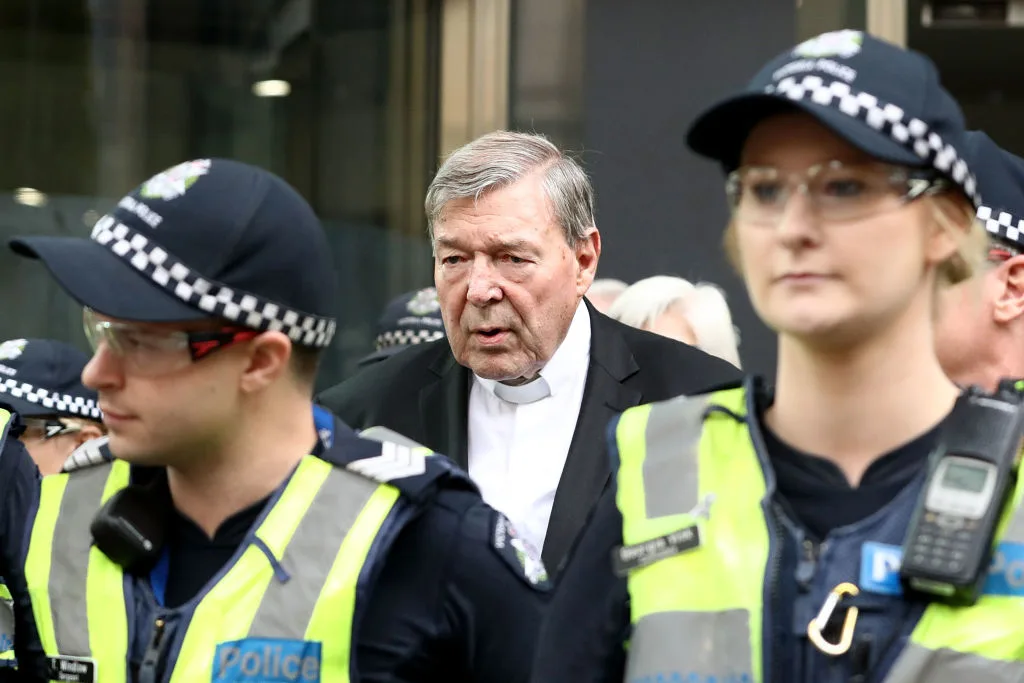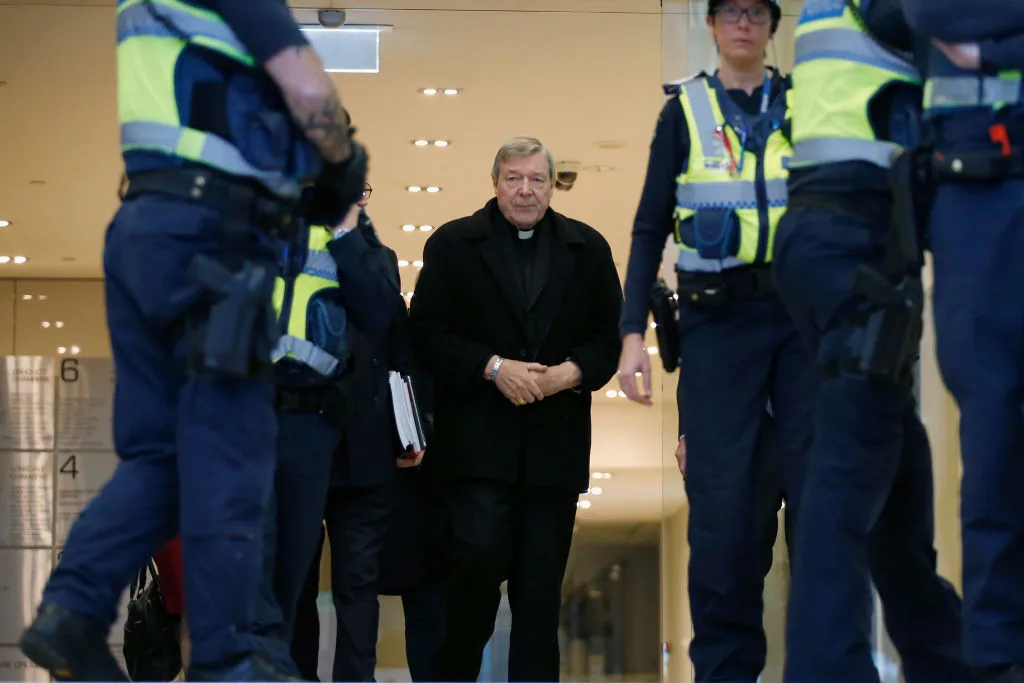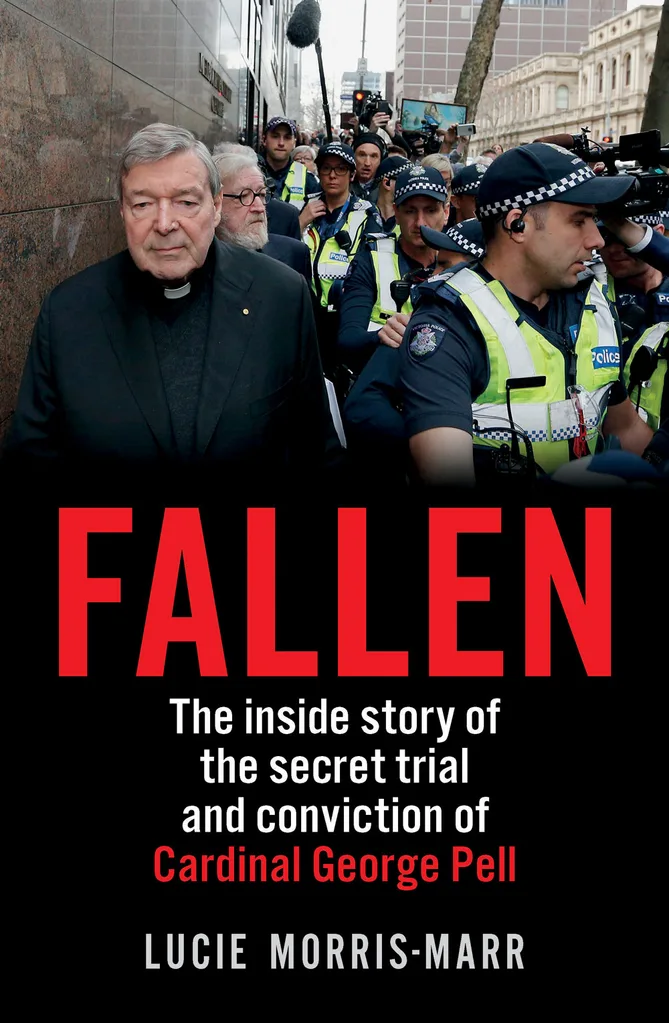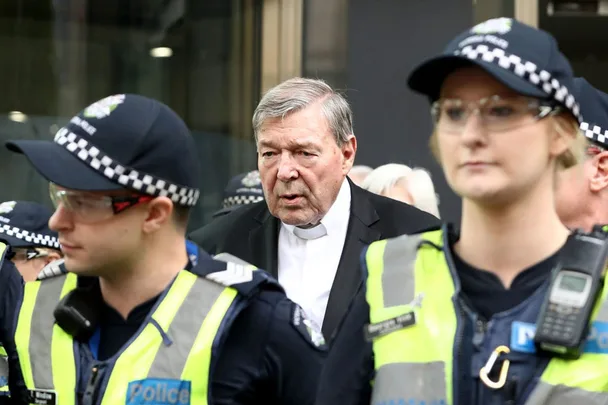It’s only a short drive from the county court to Melbourne Assessment Prison, commonly known as MAP, on nearby Spencer Street. But seated in the back of a white Mercedes prison van, the prospect of what awaited inside the high-security compound must have been nothing less than terrifying for Cardinal Pell. Never before in his 77 years had his personal Latin motto Nolite timere—be not afraid—been more needed as he faced what lay ahead.
Watch Below: Cardinal Pell Appeals His Prison Sentence.
The facility, opened in 1989, has a capacity of 305 male prisoners and the cardinal would soon find out that he would be spending 23 hours a day in a cell in a unit dubbed by the staff ‘sep, sep’. ‘It’s like a segregation unit within a segregation unit, it doesn’t get more isolated that that,’ a source explained. The cardinal would be allowed only one official visitor a week but could have as many legal visits as was necessary.
When he arrived on the evening of 27 February 2019, he was taken to his cell with its basic bed, thin mattress, TV and a metal toilet in the corner. He was met by senior staff and a prison psychologist to check his mental state. ‘They gathered around him for some time, explaining the rules and routine. One of their prime concerns with a new prisoner is whether they are at risk of self-harm, which is common,’ the source said.
‘Pell was told he wasn’t going to be mixing with any other prisoners at all, as it was too high risk. He would only mix with staff, but mostly he’d be in his cell.’
The fear Pell could be harmed was justified. In the past decade high-profile prisoners in Victoria’s prison system have been attacked, most notably murderer and drug trafficker Carl Williams, who died from a head injury in April 2010. Fellow inmate Matthew Johnson was later sentenced to 32 years in jail for using part of an exercise bike as a fatal weapon against the notorious underworld figure.
Corrections staff were also still on high alert after infamous Victorian drug dealer Tony Mokbel was knocked unconscious before being stabbed up to seven times in a frenzied assault with a makeshift knife at Barwon Prison, a maximum security jail outside Melbourne. The brutal attack by two fellow prisoners happened just 16 days before Pell was remanded in custody.

Ostensibly Pell may have been kept safe from attack by being unable to mix with the general prison population, but his new ‘housemates’ in neighbouring cells would turn out to be some of the most notorious criminals in the state. Bourke Street killer James Gargasoulas, who was jailed for life for committing one of Australia’s worst mass murders when he drove his car into pedestrians in the centre of Melbourne, was in a cell directly next to the cardinal. In other neighbouring cells terror suspects languished on their beds watching television. No phones or internet access are allowed.
‘Usually, once all the publicity calms down around a high-profile prisoner they are allowed to mix with other crooks in more open units but I don’t think that’s ever likely with Pell,’ the source said. ‘It’s just too risky that someone might take him out or harm him.’
The nights in MAP, when prisoners can hear the vivid yet unreachable sounds of inner-city life from surrounding streets including the sharp horns of taxis and rattling trams, can be long and brutal. ‘Inmates sometimes shout out in the darkness, they cry and verbally abuse each other, but generally Pell’s row of cells was calm.’
Despite the constraints of his new abode, Pell apparently settled in without much fuss, co-operating with the guards and doing as instructed. He would spend the long hours alone in his cell reading books, praying and writing letters to friends who were sending regular dispatches of hope and support. He wouldn’t be able to have wine, so taking communion on a Sunday was out of the question.
A grace period exists for the first seven days of a prisoner’s arrival at MAP during which anyone with suitable ID may drop off property or money for a prisoner. After this time, this is limited only to people registered on the prisoner’s visit list.
‘I tried to visit several times but I was turned away,’ says Anne Lastman, Pell’s close friend from Perth who had attended much of the court proceedings.3 ‘It broke my heart knowing he was in there, locked up and alone.’

For a man once in charge of balancing billions of euros as the Vatican’s treasurer, he was now restricted to having a maximum of just $140 Australian dollars a month to spend on prison issue snacks and toiletries. The cardinal would also have to get by with fewer clothes and effects than he was used to. Prisoners at MAP have to abide by strict rules regarding personal items. Pell had been informed through his legal team that he was only allowed to bring the following clothes and items into the prison:
6 pairs of jocks or boxer shorts
6 pairs of socks
2 singlets
2 windcheaters or tracksuit tops or jumpers or jacket [no hoods, camouflage or quilted/puffy items accepted]
Professional court clothing [trousers, jacket, shirt, tie, dress shoes]
4 tops [t–shirt, polo top, long sleeve]
4 bottoms [tracksuit pants, trousers, jeans, shorts]
1 pair of pyjamas
1 pair of shoes/runners
1 belt [small buckle—subject to prison discretion]
1 pair of scuffs/slides/thongs
2 pairs of prescription glasses & soft case
1 cap
6 books
6 magazines
6 photographs (laminated/polaroids not accepted)
Every aspect of his life was now controlled and restricted—right down to his underwear. Dignified it wasn’t.
Former priest Eugene Ahern sent his close friend Pell a pop-up card covered in bright flowers almost as soon as he was remanded to try and ‘cheer him up’. ‘I’m loyal to George because he sent me a wonderful letter himself when I was going through a hard time myself, after I left the priesthood,’ he explained. ‘I left for the sake of my mental well-being, I was clinically depressed and my doctor felt I would be better out of the ministry.’
It seemed Pell would have no shortage of other correspondence from loyal friends and requests to visit. He reportedly told friends he had come to view his incarceration as an ‘extended retreat’. That was certainly an optimistic way to look at his new life in solitary confinement.
If his legal bid for freedom failed, a correction source predicted it would be ‘highly likely’ that Pell would be moved to Hopkins Correctional Centre, a medium security prison 200 kilometres west of Melbourne in Ararat. It is here that a large proportion of approximately 700 inmates are serving sentences for child sex offences and are kept apart from the general prison population for their own protection. If the court decides it’s not safe to release paedophiles at the end of their sentence, they are then sent to live in small units of approximately 50 men in an outer, minimum security section called Corella Place, dubbed locally as the ‘village of the damned’.
Waiting to greet Pell at the facility would be his former housemate Gerald Ridsdale, who isn’t eligible for parole until 2022 after pleading guilty in 2017 to abusing 12 more children. He might also recognise Robert Claffey, a peer from his days in the seminary in Werribee, who is likely to die in jail after three convictions for child abuse. On 8 July 2019, perhaps thanks to the courage of survivors who came forward to the police and royal commission, two new male victims came forward and made complaints that Claffey had indecently assaulted them while working as a priest in Ballarat in the 1980s. One was just seven years old at the time. The 76-year-old pleaded guilty to four more charges.
With the very pressing possibility of an unwanted reunion with disgraced former clergy associates on the horizon, Pell’s powerful friends in high places were continuing to rally around him. The newly installed Archbishop of Melbourne, Peter Comensoli, vowed to visit his friend in prison, and former prime minister Tony Abbot, himself a former seminarian and high-profile Catholic, had personally called the cardinal on the day the suppression order was lifted.
Food cooked fresh daily by fellow prisoners in the kitchens for a small wage was delivered to prisoners’ cells. Pell would have enjoyed curries with rice and vegetables, roast dinners and chilli con carne, all popular menu items in the prison. Nevertheless, when we saw Pell again two weeks later for his sentencing hearing he appeared pale, gaunt and noticeably thinner. After fourteen long nights spent in a tiny cell in solitary confinement, his Eminence had apparently lost his appetite.
This is an extract from Fallen: The inside story of the secret trial and conviction of Cardinal George Pell by Lucie Morris-Marr; $29.99; Available from all good bookshops or online at Booktopia.

It’s only a short drive from the county court to Melbourne Assessment Prison, commonly known as MAP, on nearby Spencer Street. But seated in the back of a white Mercedes prison van, the prospect of what awaited inside the high-security compound must have been nothing less than terrifying for Cardinal Pell. Never before in his 77 years had his personal Latin motto Nolite timere—be not afraid—been more needed as he faced what lay ahead.
Watch Below: Cardinal Pell Appeals His Prison Sentence.
It’s only a short drive from the county court to Melbourne Assessment Prison, commonly known as MAP, on nearby Spencer Street. But seated in the back of a white Mercedes prison van, the prospect of what awaited inside the high-security compound must have been nothing less than terrifying for Cardinal Pell. Never before in his 77 years had his personal Latin motto Nolite timere—be not afraid—been more needed as he faced what lay ahead.
Watch Below: Cardinal Pell Appeals His Prison Sentence.










